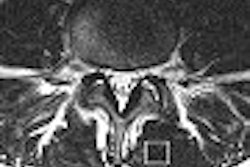Following the American College of Radiology (ACR) Appropriateness Criteria for determining the best use of diagnostic imaging modalities led to more appropriate MRI use by the Israeli air force, according to a recent study.
"Introduction of the ACR Appropriateness Criteria resulted in an increase in the rate of performance of appropriate MRI examinations and a decrease in the rate of performance of inappropriate MRI examinations," wrote the authors of a study published in the American Journal of Roentgenology (October 2006, Vol. 187:4, pp. 855-858).
The authors reviewed the records of all MRI requests received at the Israel air force preauthorization center over a 19-month period. The center, located in the Surgeon General Headquarters in Tel-Hashomer, Israel, is staffed by two medical officers who are general practitioners, not radiologists.
The researchers divided their study into two phases: a review of MRI authorizations and denials prior to the introduction of the ACR Appropriateness Criteria, and a review of MRI approvals and denials after the utilization of the ACR guidelines. The group also examined the approval and denial rate according to anatomic system.
The first phase was conducted between February and December 2002; a retrospective evaluation of all MRI requests during this period was conducted by a radiologist familiar with ACR guidelines. In March 2003, the radiologist conducted a two-hour teaching session on the ACR Appropriateness Criteria with the medical officers at the preauthorization center, then provided a week of tutoring to the officers during their working hours.
"The decision to use the ACR guidelines for evaluation of each MRI request was left to the medical officers' discretion; use of the guidelines was not obligatory," the study authors wrote.
The second phase of the study was conducted between April and December of 2003. The preauthorization physicians were asked to fill out a form for every MRI evaluation request. According to the researchers, the following data were gathered:
- ACR criteria used or not
- Reason for not using the ACR criteria if not used
- ACR clinical variant used for approval or denial of the request
- ACR appropriateness value assigned to the request
The study team also acquired and evaluated information regarding the anatomic system of the MRI request and whether it was approved or denied. The authors noted that the two phases of their study were of different length (11 months and nine months, respectively), which they attributed to organizational constraints of the air force health system.
"However, because the study was focused not on utilization patterns of MRI but on the decision-making process and results inside the preauthorization center, we believe no bias was introduced by this variation," they wrote.
A total of 194 requests from the first phase of the study and 164 requests from its second phase were reviewed by the research team. Before the introduction of the ACR Appropriateness Criteria, the preauthorization center approved 74% of the appropriate MRI requests and 100% of the inappropriate and indeterminate requests. The overall request approval was 84% in the first phase.
After introduction of the ACR guidelines, the preauthorization center approved 97% of the appropriate MRI requests, 30% of the inappropriate requests, and 100% of the indeterminate requests. The overall request approval rose to 86% in the second phase of the study.
The introduction of ACR Appropriateness Criteria into the preauthorization system also improved the appropriate use of MRI by anatomic region. In the first phase of the study, 100% of head, 51% of knee, 97% of spine, and 100% of shoulder exams were approved. In the second phase, the use of MRI was approved for 98% of the head studies, 61% of the knee exams, 72% of the spine evaluations, and 86% of the shoulder imaging requests.
The use of ACR guidelines by the general practitioners in the preauthorization center significantly improved the appropriate use of MRI in the air force health system, the authors noted.
"However," they wrote, "use of radiologists as reviewers may have an advantage over use of general practitioners because radiologists have hands-on familiarity with imaging techniques, especially those that are alternatives to MRI."
The authors noted the study cohort was comprised of active-duty air force personnel, which does not represent a general healthcare population, and that did they not seek to formally educate the referring physicians as to ACR guidelines for the appropriate use of MRI. However, they believe that use of the ACR Appropriateness Criteria can lead to better utilization of MRI.
"With the emergence of credible guidelines such as the ACR Appropriateness Criteria and the Royal College of Radiologists' Evidence-Based Guidelines, implementation of preauthorization programs for expensive imaging examinations may be a solution for improvement of patient care and reduction of imaging costs," they wrote.
By Jonathan S. Batchelor
AuntMinnie.com staff writer
October 3, 2006
Related Reading
MRI overordered by primary physicians for back pain, January 31, 2006
Cautions against CT overuse fall on deaf ears at West Virginia ER, September 27, 2005
Massachusetts insurers seek to cut imaging utilization, September 12, 2005
Study finds MRI is overused in sports medicine, February 24, 2005
ACR criteria cut imaging costs in Israel, January 11, 2005
Copyright © 2006 AuntMinnie.com



















